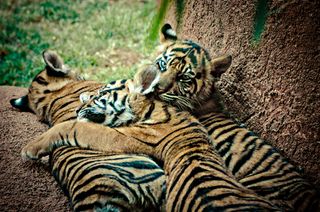
U.S. 'Pet' Tiger Trade Puts Big Cats at Great Risk (Op-Ed)

Nicole Paquette is the vice president of wildlife protection at The Humane Society of the United States. She contributed this article to Live Science's Expert Voices: Op-Ed & Insights.
Threatened with extinction in the wild, tigers are struggling to survive and regain their once-thriving populations against pressures caused by habitat loss, poaching and conflicts with an ever-increasing human population. Their numbers are estimated to be in the low thousands.
On the other hand, tigers in captivity face a different set of problems. They are bred repeatedly and forced to produce litter after litter — so many litters that there are now far too many tigers in the United States, and not enough responsible and experienced facilities to care for them.

Tiger overpopulation?
One of the main causes of tiger overpopulation in the United States is some facilities use tiger cubs for public handling. For a fee, members of the public can play with, bottle-feed, swim with or have their photo taken holding a tiger cub. Tiger cubs are typically handled by the public until they are only three to four months old, then they are discarded and a new batch of tiger cubs are brought in for the next few months of public handling and the cycle of breeding and dumping continues. [Sumatran Tiger Cub Born at Sacramento Zoo ]
The HSUS has documented facilities that offer photo ops with tiger, lion or bear cubs sending the older, unwanted animals to roadside zoos with histories of violating the federal Animal Welfare Act, and, in the case of African lions and bears, sending them to facilities where they are slaughtered for their meat.
No one knows where all these unwanted tigers end up because they are not tracked by the federal government. A good many end up warehoused in substandard roadside zoos. And some are portrayed as "rescued" animals by phony sanctuaries in order to convince caring people to give them money. Those pseudo-sanctuaries are not accredited by the Global Federation of Animal Sanctuaries and lack the knowledge, facilities, and resources to provide long-term humane, safe, and appropriate care for complex species, such as tigers.
Sign up for the Live Science daily newsletter now
Get the world’s most fascinating discoveries delivered straight to your inbox.
Tigers are not pets
Other tigers end up in the pet trade. Some tiger cub operators actually place "free to a good home" classified ads for their older, unwanted tiger cubs. Some tigers may be killed illegally and their body parts sold on the black market. Investigators with the U.S. Fish & Wildlife Service uncovered a group of individuals and small business owners in the Midwest that bought and killed tigers and other exotic animal species with the intention of selling the meat, skins, bones and organs into the lucrative trade in animal parts. A total of 17 defendants in seven states were charged and convicted as a result of the investigation. A tiger is actually worth more dead than alive. [Boas, Chimps or Tigers: Wild Animals Are Not Pets (Op-Ed )]
Very few of the beautiful and majestic big cats will be lucky enough to end up at reputable, properly run sanctuaries.
Besides causing a "homeless tiger" problem in the United States, facilities that offer photo ops with tiger cubs cause a great deal of harm to the cubs, as well as their mothers. Like puppy mills, tigers are bred more often than they should be. Undercover investigations and U.S. Department of Agriculture (USDA) documents confirm that during or shortly after birth, tiger cubs at most unaccredited zoos are taken from their mother to be hand-raised, which is very upsetting to the fiercely-protective mother and deprives the cubs of maternal care that is vital to their long-term health and development.

Professionals with zoos accredited by the Association of Zoos and Aquariums recommend that mother tigers be allowed to raise their cubs because the mothers will do a better job and parent-reared cubs are usually better adjusted behaviorally. Additionally, the USDA's big cat specialist has found that privately-owned, hand-reared tigers appear to have the highest incidence of metabolic bone disease which is the result of cubs being fed a nutritionally-deficient diet.
Investigating "photo ops"
The HSUS recently conducted investigations at two facilities that offer photo ops with tiger cubs. Public handling began at about three weeks of age, when it was unsafe for the cubs, and lasted until it was unsafe for the public, when the cubs were more than 17 weeks old and weighed about 50 pounds.
Of great concern was the constant stress that public handling caused the tiger cubs. Their schedules revolved around photo ops, so they were denied proper food and rest, as well as adequate veterinary care. Cubs who were sick, exhausted or screaming from hunger were still required to sit still for a parade of customers wanting a photo op with a tiger cub.
A petition filed by a coalition of organizations, including The HSUS, to put an end to this practice is pending with the USDA. In the meantime, steer clear of any place that advertises photos with tiger cubs. Not only are these places not helping wild tigers, they are causing great harm to those in captivity by denying them maternal care, exposing them to stressful public handling, and contributing to the problem of surplus tigers.
Follow all of the Expert Voices issues and debates — and become part of the discussion — on Facebook, Twitter and Google+. The views expressed are those of the author and do not necessarily reflect the views of the publisher. This version of the article was originally published on Live Science.
